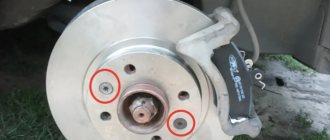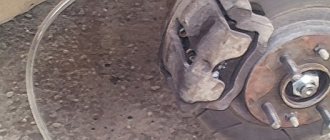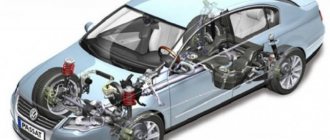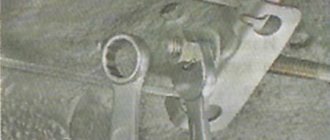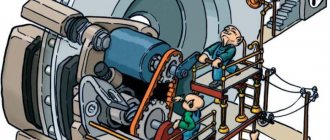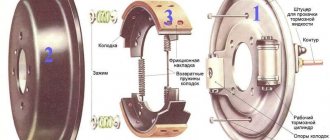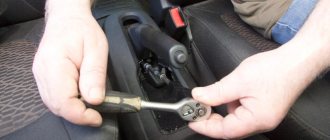What to do if the handbrake pads are frozen? We are considering ways to get out of the situation on our own.
It would seem that if the brake pads are frozen, the only logical action is to start panicking. Well, how could it be otherwise, if you can’t move from the spot, and there’s also a risk of completely tearing off this part and going straight to the service department. Let's take our time and try to get out of the situation calmly and independently.
First of all, it is worth understanding why this happens. The pads can freeze after the car has been driven through a puddle or been in a car wash. When sub-zero temperatures occur, moisture freezes and the pads become stuck. Depending on which structures are covered in ice, there are several ways to defrost them.
Method 2. Heat from exhaust gases
To do this, you will need a large diameter hose and an appropriate length. One end of the hose is connected to the exhaust pipe, and the other is directed to the inside of the rear wheels.
A hose from an old vacuum cleaner will do. A few minutes and the brakes will warm up - the car will be able to move.
How to move away if the brake pads are frozen. Advice for motorists
Brake pads often freeze in winter - when it's warm enough during the day and the temperature begins to drop at night. If they are frozen, then the driver cannot move away immediately - such an approach can damage this unit in the car. However, even in this situation, you can quickly revive the car.
But the driver needs to decide what to do only after finding out the reasons and degree of freezing. But, it is better to act preventatively - there are several ways to prevent brake pads from freezing. moyidorogi writes about this.
Why do the pads freeze and signs of this condition?
There are two main reasons why a car cannot drive in winter - technical (malfunction of the brake system) and freezing itself. Parts of the braking system, mostly the rear wheels, often freeze. This is a common “winter” problem, which, however, can be easily avoided if you know the reasons for freezing. The pads are most often frozen in ice in the following circumstances:
- after visiting a car wash in winter, when the car then sits outside at night;
- During the day everything thawed, there was slush or dirt on the street that the driver did not clean off;
- condensation that forms on the surface of parts and gradually freezes.
Freezing of brake pads is the result of a car being left on the street for a long time, when the car is not parked in a garage, but simply near a house or in an open parking lot. It occurs due to insufficiently dried brakes when the car is left for a long time in the cold with the handbrake. The manifestations of the condition when the brake pads are frozen by ice are different - they depend on the structure of the brake system mechanisms, as well as on the type of vehicle drive. However, there are some characteristic signs of freezing - they are common and in fact always indicate this particular problem. Manifestations of freezing of brake parts, which are easy to identify, are expressed as follows:
- The car does not move, and when trying to move the car, the engine stalls. This is a sign of freezing of the brake pads of the drive axle.
- The car starts moving, but at the same time there is an increased load on the engine, and the rear of the car sags noticeably when it starts moving. This indicates frost gripping of the driven axle components.
- From the beginning of the movement, the car begins to “steer” to the side, and the load on the steering column increases. This is a sign that the brake pads of one of the wheels are freezing.
Attention! It is not only the freezing of the drive axle brakes that “immobilizes” the car. Sometimes the car cannot be moved because the wheels of the drive axle are frozen to the ground - this also must be taken into account when searching for the cause.
How to defrost pads and prevent them from freezing
First, in order to understand the severity of the situation, the driver needs to try again, as smoothly as possible, to move away. If the car runs, then the mechanism is not very frozen, and you can drive carefully. But, if the car has not moved, then you cannot force it - the likelihood that the elements of the braking system will be damaged is now increased. When the pads are frozen heavily, you can perform the following actions:
- When the thermometer mark outside does not drop lower than -15˚ C, you can defrost the brake pads by spilling them and the discs with warm water. But, if you use this method, you need to go right away - before the elements are frozen again. But, if it is very cold outside, then such actions can cause even more icing.
- When the temperature has dropped to -20˚ C or less, a heat gun or a hair dryer is used to defrost the braking system - when it is possible to connect these devices to the electrical network. During manipulation, you must be careful so as not to spoil the rubber or paintwork on the discs.
- A relatively effective, but time-consuming and expensive way to defrost brake pads is to warm them with exhaust gases. A hose is put on the pipe and its other end is brought to the problem area.
- You can crumble the ice on the mated pads - carefully tap them and the brake disc (drum) lightly, placing a plank on them.
- An effective way to “warm up” the car’s brakes is to treat them with special fluids, which are classified as lock defrosters. You can also use aerosols with similar properties or a glass surface cleaner. But glass cleaner must have a freezing point lower than water.
On a note! Not only special lock defrosters are suitable for defrosting brake discs, but also alcohol or gasoline. This will take more time, but in desperate situations, when you need to go somewhere urgently, it’s a good solution.
When the problem is solved and the car is “on the road” again, the driver needs to take measures that will prevent ice from blocking the pads in the future - so as not to waste time later. It is quite simple to reduce the likelihood of brake system elements becoming frozen in ice; preventing pads from freezing in winter involves following these recommendations:
- Take the car to a car service center so that the technicians check and adjust the clearances of the wheel braking system - this will reduce the risk of freezing, since almost no water will get into them.
- Do not leave the car on the street for a long time using the handbrake. In the case of cars with automatic transmission, it is recommended to select the ““ mode; for manual transmission, leave it “in gear” - first or reverse. If there is no other way to park the car except using the handbrake, then the lever is first moved to the working position, after 10-20 minutes. released. This technique will cause the resulting ice to crumble. Then you can pull the handbrake again.
- Before stopping the car for a long time, the brakes must be dried. To do this, they brake sharply several times in a row.
- It is better to drive around mud, puddles and not use the car in slush. If this cannot be avoided, be sure to dry the pads after the trip.
When the brake pads freeze in winter and the car cannot be moved, there is no point in “forcing” the car to drive.
It is easy to determine that the cause of immobility lies precisely in frozen brakes. You can defrost ice-bound elements quite quickly - there are many simple ways that will not only help return the car to operation, but also reduce the risk of damage to the brake system. However, it is better to prevent freezing and, if possible, reduce the duration of use of the handbrake in winter. If you find an error, please select a piece of text and press Ctrl+Enter .
Share
Method 6. Male
I think there is no need to explain anything here. Many people know how to put out a fire like a pioneer. If the brakes are frozen far from civilization, this is perhaps the only available way to revive them. True, this method is ineffective. The principle itself is important: hot water hits frozen brakes and melts the ice. So if you can boil water in a kettle and pour it over the brake mechanisms, you are guaranteed success. However, it is not advisable to use boiling water.
You need to pour hot water over the drums until the pads come off. At the end of the procedure, it is advisable to dry the rear wheel brakes. Moving briefly with the handbrake slightly tightened will help with this. This technique for drying the brakes is recommended every time after driving through deep puddles and before leaving the car in the parking lot.
Has a similar problem ever happened to you? How did you solve the problem of frozen brakes?
- The weather reminds us of auto accessories like radiator guards, windshield drains and heated wipers. It would be a good idea to keep a set of wheel bracelets in the trunk.
- In our online store, prices for technical literature, repair manuals, and books and magazines from the Za Rulem publishing house have been reduced.
- Behind the wheel" can now be read on VKontakte.
What to do if the pads are frozen on a car with drum brakes
Under no circumstances try to drive with force to free frozen pads. The engine has plenty of power for this, but you risk tearing off the pad linings or damaging the transmission. It’s better to use one of the proven methods.
Kick the wheels and rock the car
Sometimes even such banal advice can work. If there is not much ice inside the drums, it will easily come off with a few hits on the rear wheels.
The crunch of broken ice will be evidence that everything worked out.
A similar effect can be achieved by rocking the car well from side to side.
Tap the drums with a hammer
This method works flawlessly. Ice is also destroyed by impacts, but not on the wheel, but on the brake drum body, and not with a foot, but with a hammer or other heavy object.
On a car with alloy wheels, you can tap the drums through the spaces between the spokes. If the discs are stamped, then most likely you cannot do without removing the wheels. But first you can try tapping the mounting bolts.
You should not hit it very hard and preferably not directly, but through some kind of spacer like a piece of wood or a wheel wrench, so as not to damage the body.
In most cases, 3-4 confident hits around the perimeter of the drum are enough. As soon as the pads come off, you will immediately understand this by the characteristic sound of crumbling ice.
All that remains is to repeat the procedure for the second wheel.
Warm up the drums with water
In principle, this option is no worse than the previous one. It comes in handy when there are no tools at hand, but there is warm water. Plus, you don't have to remove the wheels.
It is better not to use boiling water to prevent the cases from cracking due to temperature changes. Take hot or even warm water and pour it little by little onto the discs so that it hits the brake drum. The kettle is usually more than enough for both wheels, although it all depends on the situation.
After defrosting, drive off immediately, otherwise the pads may freeze again.
Warm up the drums with air
If you have a sufficiently long hose at hand, you can warm up the pads using the heat of the exhaust gases.
To do this, put on or insert one end of the hose into the muffler, and direct the other into the holes of the discs so that the exhaust gases enter the drum body. Increase the engine speed slightly to speed up the process, and when you hear the characteristic click of the pads being released, repeat the procedure for the second wheel.
Instead of gases, you can use any other heat source except open fire. For example, a hair dryer or an infrared heater.
Why do the pads freeze and signs of this condition?
There are two main reasons why a car cannot drive in winter - technical (malfunction of the brake system) and freezing itself. Parts of the braking system, mostly the rear wheels, often freeze. This is a common “winter” problem, which, however, can be easily avoided if you know the reasons for freezing. The pads are most often frozen in ice in the following circumstances:
- after visiting a car wash in winter, when the car then sits outside at night;
- During the day everything thawed, there was slush or dirt on the street that the driver did not clean off;
- condensation that forms on the surface of parts and gradually freezes.
Freezing of brake pads is the result of a car being left on the street for a long time, when the car is not parked in a garage, but simply near a house or in an open parking lot. It occurs due to insufficiently dried brakes when the car is left for a long time in the cold with the handbrake. The manifestations of the condition when the brake pads are frozen by ice are different - they depend on the structure of the brake system mechanisms, as well as on the type of vehicle drive. However, there are some characteristic signs of freezing - they are common and in fact always indicate this particular problem. Manifestations of freezing of brake parts, which are easy to identify, are expressed as follows:
- The car does not move, and when trying to move the car, the engine stalls. This is a sign of freezing of the brake pads of the drive axle.
- The car starts moving, but at the same time there is an increased load on the engine, and the rear of the car sags noticeably when it starts moving. This indicates frost gripping of the driven axle components.
- From the beginning of the movement, the car begins to “steer” to the side, and the load on the steering column increases. This is a sign that the brake pads of one of the wheels are freezing.
Attention!
It is not only the freezing of the drive axle brakes that “immobilizes” the car. Sometimes the car cannot be moved because the wheels of the drive axle are frozen to the ground - this also must be taken into account when searching for the cause.
Why did they freeze?
Drivers sometimes do not dry their brakes enough during frosty weather, and then, on a whim, they lock the car with the handbrake. In the case of a manual transmission, this is a condition for the correct activation of autostart.
Sometimes the reason may be more trivial - the pads were replaced, the gap was not adjusted, so they are adjacent to the brake discs, and condensation with frost will act as an anchor. There are also situations when you force a puddle, but the car has not seen a wash for a long time. Why? Everything is quite simple: even in severe frost, condensation forms on the surface of the pads and discs, which freezes as the brake mechanism cools, especially if the driver actively uses the brakes. If the driver puts the car on the handbrake, in half an hour he will no longer be able to just drive away.
Mistakes when pads freeze
The biggest mistake that drivers often make is trying to act sharply in this situation and “rip off” the brake pads by using engine force. In this case, the car owner presses the gas pedal with all his might in the hope that the engine power will help tear off the frozen parts and the ice will collapse.
It is unlikely that you will still be able to resolve the problem this way. But the likelihood of damaging the machine’s mechanisms is quite high.
The consequences of using a forceful method to “break” the pads can be as follows:
- Possibility of tearing off friction linings, which can lead to jamming of wheel mechanisms.
- In cars with drum brakes, the brake mechanism mounts become torn.
- Transmission mechanisms undergo heavy loads, as a result of which they fail. This problem especially concerns clutches and wheel drives.
This forceful method can lead to serious vehicle problems.
What not to do
The stupidest way may be a homemade burner or torch. In the case of rear brakes, you need to remember that there is a fuel tank nearby, and an open fire combined with the close proximity of the fuel tank can give you an unforgettable experience and a beautiful fireworks display for your neighbors. Of course, at your expense.
The handbrake cable is frozen
It’s much worse if the cable running from the controls to the mechanisms freezes. On cars older than 10 years, a situation occurs in which the handbrake cable protection cracks, water gets inside and interferes with its operation in cold weather. Then no matter how much you water the wheels from a bottle, you still won’t be able to remove the blockage. Only thawing or heating with an electric hair dryer will help here. True, in order to get to hard-to-reach places under the bottom of the car, you will have to drive it onto an overpass. And we still have to get there. And here you can’t do without a good master. It will help to disconnect the cable from the pads and unclench them.
Next, we drive the cars into the garages, turn on the hair dryer and methodically pass through all the problem areas of the hanging cable with warm air. If it starts working, then good. Then we coat the cracks with oil to prevent further water from entering. But this is a bad defense option. It is best to replace damaged cables.
How to avoid this problem?
To prevent this situation from happening in the future, you need to remember the following rule. After driving on wet surfaces, press the brake pedal several times. The pads will dry and there will be no moisture left on them, which can freeze in sub-zero temperatures. The best option is not to use the handbrake at all in the cold season. Another tip is to think about the position of the car when parking it. Park the car in such a way that you can start reversing. The rear brakes are much easier to unlock due to the weight of the car.
The best way to get out of an unpleasant situation is to avoid it. Let your winter trips bring only pleasure and not cause problems.

